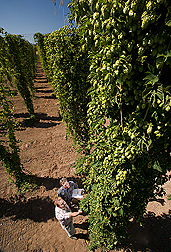| Read the
magazine
story to find out more.
|
| 
Raising hops on trellises about half the height of
the 18-footers shown here might save growers as much as 30 percent on labor
costs, according to tests by ARS geneticist John Henning (foreground) and
Oregon State University research associate Shaun Townsend. Click the image
for more information about it.
|
|

|
Lower Hop Trellises for Higher Profits
By Laura
McGinnis
January 10, 2008 When growers say "hop,"
John
Henning asks, "How low?"
Henning is a plant geneticist in the Agricultural Research Service (ARS)
Forage
Seed and Cereal Research Unit in Corvallis, Ore., where he and his
colleagues are investigating a management technique that could save hops
producers as much as 30 percent in labor costs. Oregon is one of the principal
hop-producing states in the nation, second only to Washington.
The method involves raising the hops on low trellises—about 10 feet
high, instead of the 18-foot trellises typically used in commercial production.
Lower trellises eliminate the need for two labor-intensive aspects of
production: stringing, in which hop plants are connected to hooks on the
trellis wires with strings; and training, in which the strongest shoots of each
hop plant are wired to the trellis wires to encourage the vines to grow in
clockwise spirals.
In addition, low trellis production allows for in-field harvest of hop
cones, rather than the current labor-intensive practice of cutting down plants
in the field and hauling them back to a stationary picker.
Using low-trellis production systems could have significant economic and
environmental benefits. In addition to decreasing labor costs, the systems
would enable growers to apply pesticides with directed or covered sprayers that
lower the amount of pesticides required, reducing costs and the potential for
pesticide drift.
However, not all hops are suited to low-trellis management. So Henning and
his colleagues are working to identify the gene or genes responsible for
shorter vine growth. This information will aid selection of hop varieties that
respond well to low-trellis production systems. If successful, such varieties
could save the hop industry a lot of money.
Read
more about this research in the January 2008 issue of Agricultural
Research magazine.
ARS is the U.S. Department of
Agriculture's chief scientific research agency.